
Although Apple has been criticized for lack of innovation in recent years, Apple has not always stood still. At least in terms of hardware design, with the support of the high unit prices of Apple products, its engineers can easily try some new technologies without having to consider too much cost issues.
For example, iPad Pro, as Apple's favorite "display technology" test field, iPad Pro has been at the forefront of display technology for portable smart devices from miniLED in 2021 to tandem OLED in 2024. Although the iPad Pro is not the first portable smart device equipped with a miniLED screen (MSI released a miniLED laptop a year earlier than Apple), when you compare the parameters of the two, you will quickly realize that they are not products of the same level.
However, there are not many display technologies that can be "converted" from the iPad Pro. At least miniLED has been abandoned by Apple. It generates too much heat and still cannot be called perfect halo control. In addition, it is too high The manufacturing costs eventually led Apple to give up its plan to promote this technology to MacBook, iMac and other platforms.
The new generation of tandem OLED technology is Apple’s latest choice. This is a display panel made by superimposing two layers of OLED panels. Compared with traditional OLED panels, it has significant improvements in many aspects. . This technology has quickly attracted market attention since the release of iPad Pro. It is reported that many mobile phone manufacturers are in contact with screen manufacturers, prompting screen manufacturers to accelerate their mass production plans for series OLEDs.
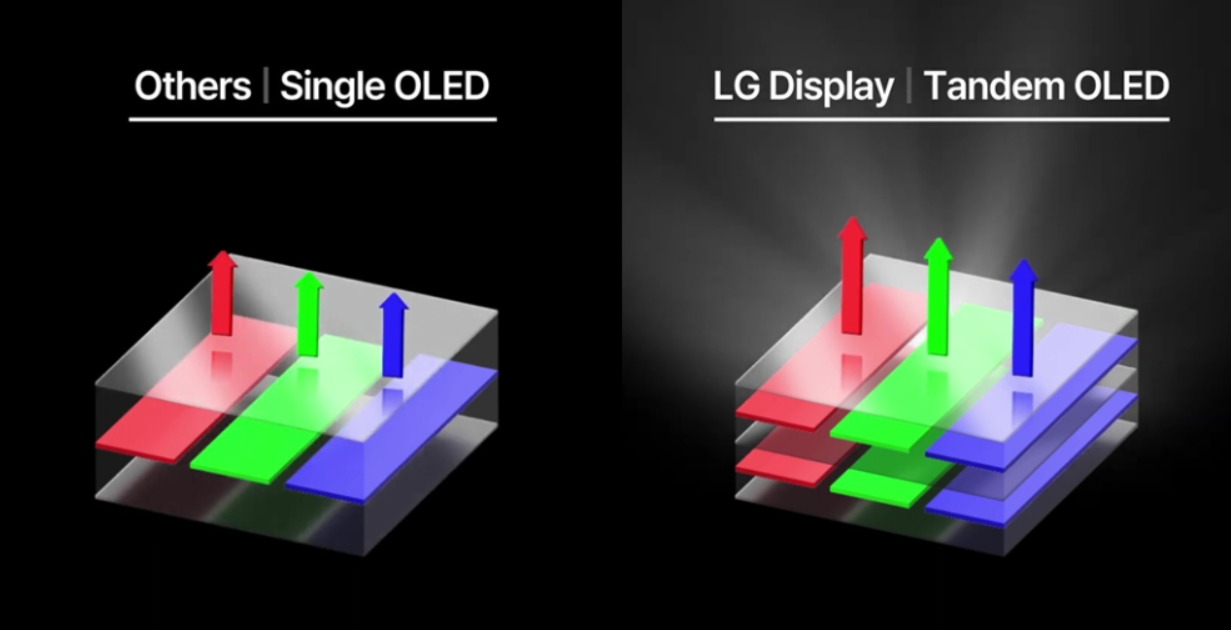
Source: aibangled
Why are tandem OLEDs more popular than miniLEDs? What devices will we see this new technology on next?
What are the advantages of tandem OLED? To put it simply, compared with traditional OLED panels, tandem OLEDs have higher brightness and longer service life, and their thickness and weight are reduced, making them more suitable for portable mobile devices.
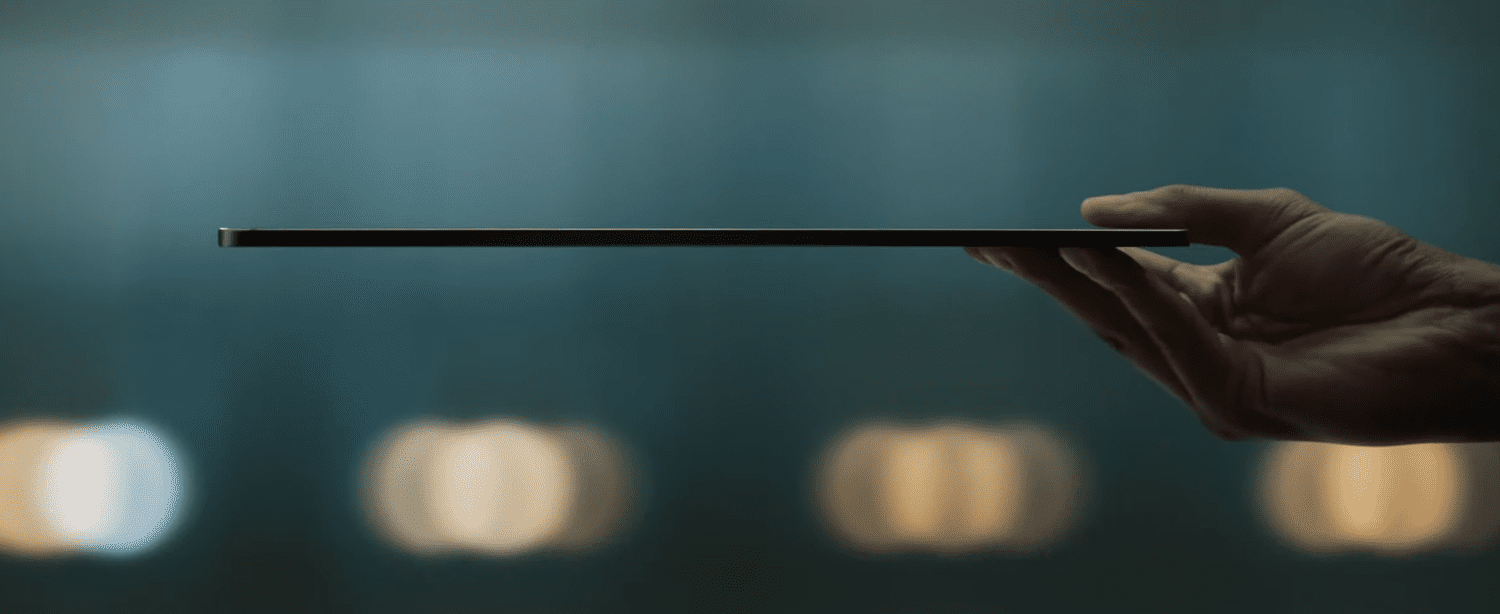
Source: Apple
Seeing this, you may have a doubt, why is a double-layer OLED panel lighter than a single-layer OLED panel? The reason is not complicated. Compared with traditional OLED panels, series OLED panels achieve high brightness by superimposing light-emitting layers, allowing the driving components and power supply circuits to be simplified during the design process, and some optical components used to increase brightness can be deleted. .
In addition, the power consumption of series OLED is actually lower than that of traditional OLED, which also allows engineers to further reduce the thickness and weight of the heat dissipation module. Are double-layer OLEDs more energy efficient than single-layer OLEDs? Although it seems a bit counterintuitive, it is true. Double-layer OLEDs are combined with special stacking technology. When displaying content with the same brightness, double-layer OLEDs have higher efficiency, which significantly reduces power consumption.
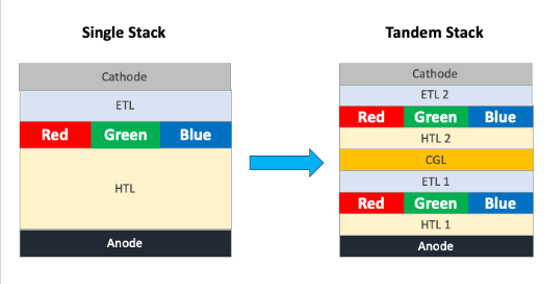
Source: MDPI
Let us briefly summarize the advantages of tandem OLED: high brightness, long life, low power consumption, low weight, almost everything needed for portable devices Advantages: Apple’s choice to abandon miniLED and switch to tandem OLED is indeed a wise choice.
And in theory, series OLEDs can continue to be superimposed. At the SID 2024 (International Display Exhibition) that ended some time ago, Hehui Optoelectronics demonstrated an OLED display panel manufactured with three layers of OLEDs in series. The brightness is as high as 6,000 nits, and it has a service life of more than 4 times that of traditional OELD screens, and the power consumption is reduced by 30% at the same brightness.
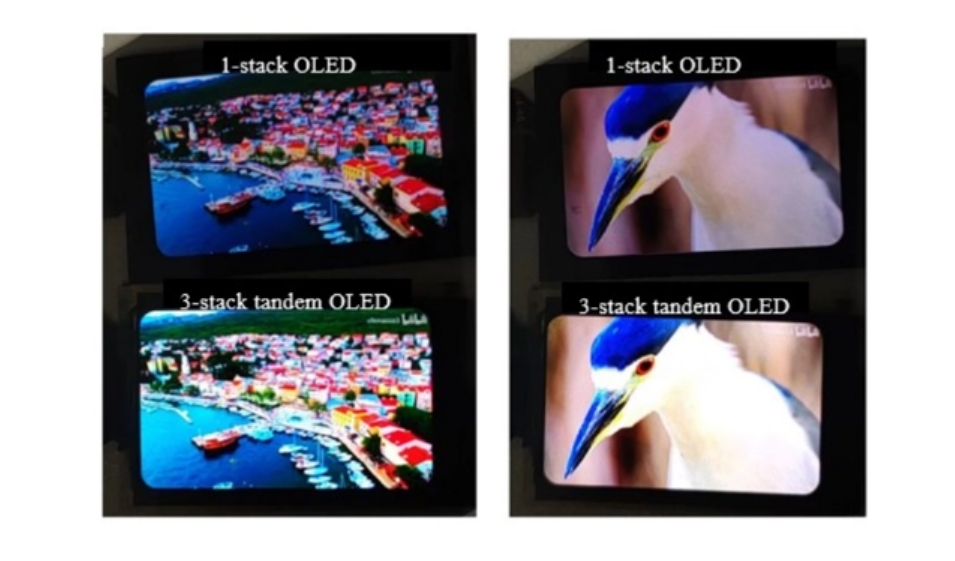
Source: Hehui Optoelectronics
So is it possible to achieve four or even more layers of stacking? It is feasible in theory, but in actual production, the more layers are stacked, the lower the yield rate, and the corresponding production cost will increase significantly. Considering the balance between cost and yield, double-layer OLED will be the best choice for some time in the future.
So there are no disadvantages to series OLED? Obviously not. The biggest disadvantage of this thing is that it is expensive. For a simple comparison, the 2022 iPad Pro with miniLED, the 256GB version is priced at 10,999 yuan, while the 2024 iPad Pro with tandem OLED is priced at 11,499 yuan, and the cost is even Higher than Apple’s customized miniLED screen.
It seems that the price has only increased by 500 yuan, but considering the impact of Apple’s adjustment of starting memory and other factors, it actually spreads the cost of the screen to the hardware premium of other parts to maintain the overall iPad Pro The pricing will not exceed the user's affordability.
According to foreign media TechRadar, the cost of tandem OLED for iPad Pro is US$270-350 (11-inch-12.9-inch), while the cost of traditional OLED panels is only US$100-150. Even taking into account factors such as the larger size of the iPad Pro, the cost of a mobile phone-sized tandem OLED panel is estimated to be more than $200.
Of course, the cost problem is not unsolvable. Currently, many manufacturers such as BOE, Samsung, and LG are beginning to expand the output of tandem OLED production lines and accelerate mass production plans. Among them, LG recently announced that it has successfully completed notebook-level series OLED mass production, successfully lighting up the last territory of portable devices.
There are so many advantages of tandem OLED, so will it replace all current OLED panels? Although the ideal is beautiful, the reality is very skinny. As the panel area increases, the tandem OLED yield rate will decline significantly.
Just imagine, the premise for the realization of series OLED is that each light bead of the upper and lower OLEDs is accurately aligned. Even for a 1920*1200 10-inch panel, the number of corresponding OLED beads will be as high as 2,304,000. As the size and resolution increase, the number of lamp beads will reach a terrifying level, and the corresponding product yield can be imagined.
So, currently only Samsung and LG have begun to supply tablet-level series OLED panels in batches. The domestically produced BOE K2 series OLED panels are currently only commercially available on mobile phones. In addition, LG has further improved the panel size of notebook computers, but if it wants to expand to desktop monitors, it may not be able to do so.
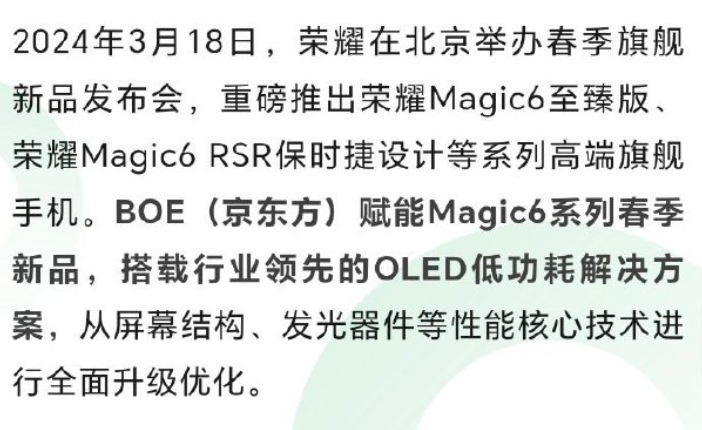
Source: BOE
Although it can be solved by spending money, the market share of monitors is far less than that of mobile phones and laptops, and desktop users have concerns about parameters such as power consumption, weight, and thickness. Not sensitive either. Although the brightness performance of tandem OLEDs is outstanding, there are more low-cost methods to achieve brightness enhancement on the desktop, and tandem OLEDs are not the only option.
As for the higher-level TV market, series OLED is even more cost-effective. Not to mention that miniLED technology is now very mature in the TV field and can easily achieve thousands of partitions + thousands of extremely high brightness parameter. Even compared to OLED TV itself, series OLED does not have much advantage. Large-size OLED TVs can also improve brightness and lifespan through a variety of technologies. The actual effect is not much worse than series OLED, but the cost is much lower.
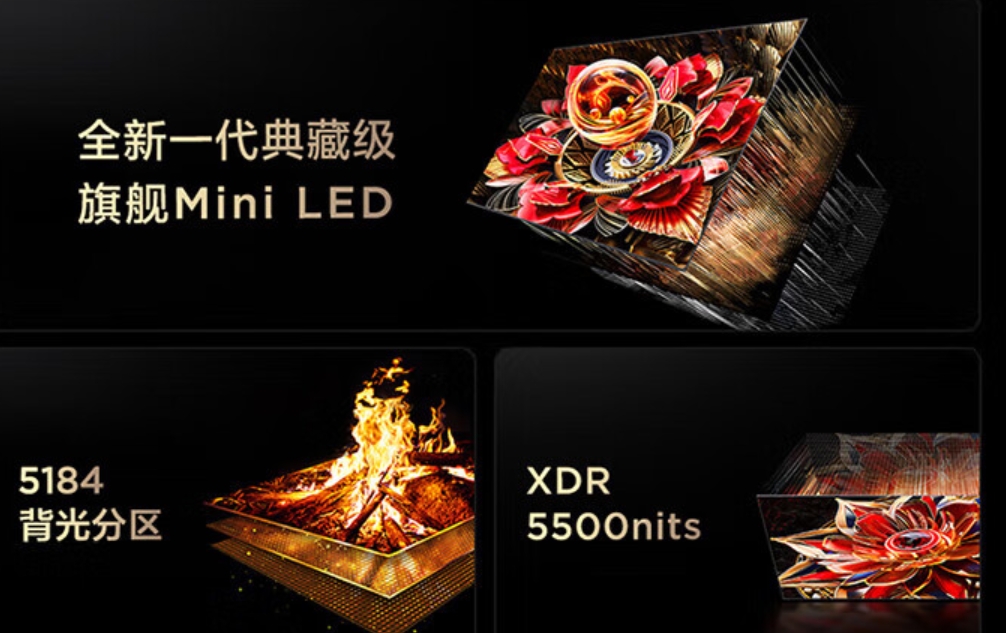
Source: TCL
Moreover, microLED is also eyeing the TV market. Although the price of microLED TV is astonishingly high today, with the decline in mass production costs, there is also a broad market market prospects.
It is basically certain that series OLED will most likely only be used on mobile devices in the next one or two years, and it will be the first to be popularized on mobile phones, with Honor Magic6 RSR leading the way, presumably Xiaomi and OPPO , vivo and other manufacturers should not be much slower in following up.
My personal guess is that in 2025 we should see more flagship phones using tandem OLED panels, and Apple may also consider using tandem OLED screens on iPhone 17 or 18. In fact, as processor performance increases, mobile phones are facing more stringent battery life tests even with more advanced process technology support. This is also forcing mobile phone manufacturers to look for lower power consumption display panels, and series OLED Exactly meets this need.
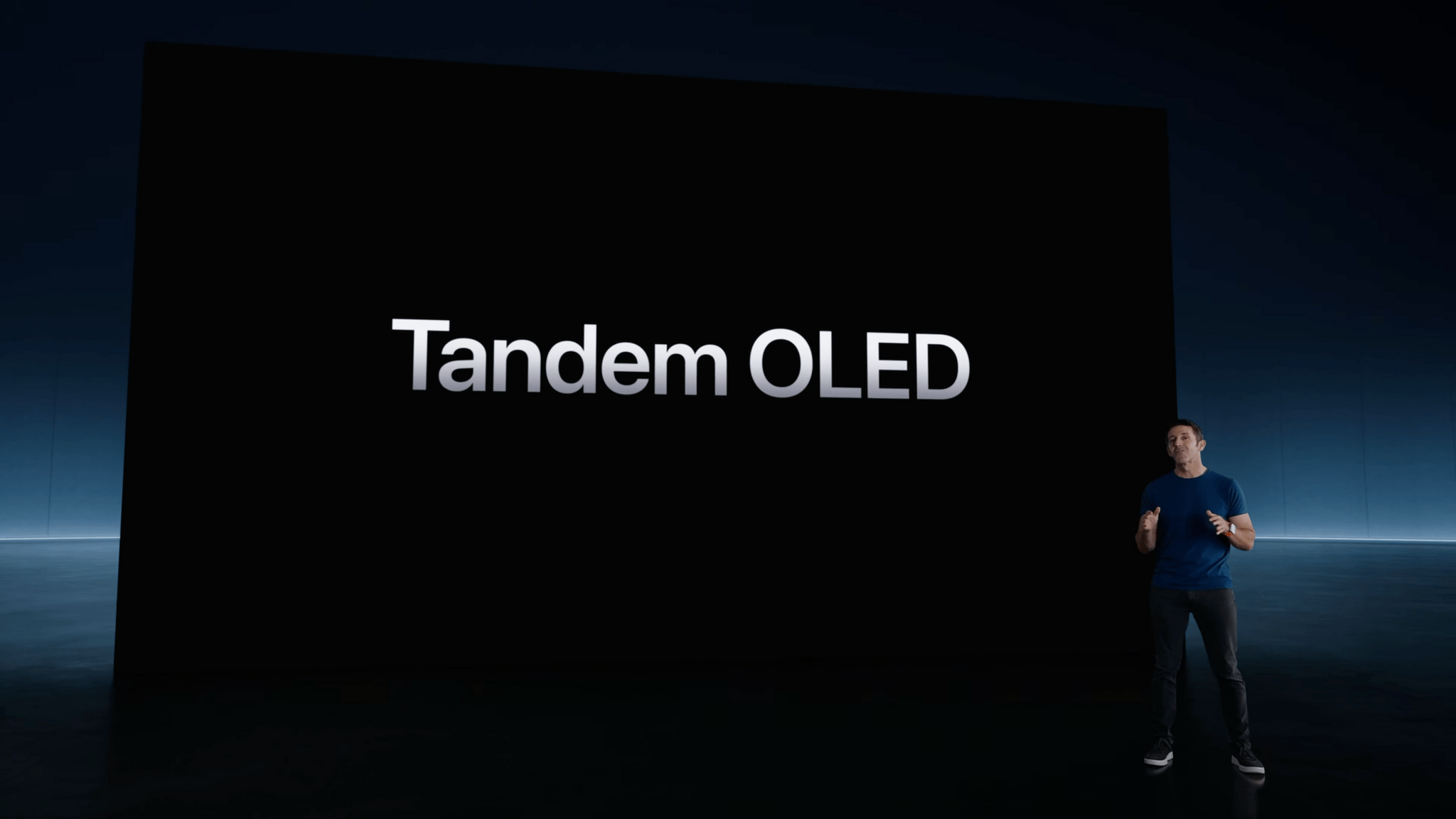
Source: Apple
Moreover, in addition to higher cost, series OLED has too many advantages, including power saving, thinness and long life, which is suitable for high-frequency devices such as mobile phones. In terms of equipment, it is undoubtedly a better choice. As for the cost issue, as I said before, this is not unsolvable. Samsung, LG and BOE have all achieved mass production of mobile phone-sized series OLED panels. If manufacturers such as CSOT Optoelectronics also enter the battlefield in the future, it is estimated that the cost will soon fall to The range that everyone can tolerate.
Although the prospects of tandem OLED look very good, in the final analysis, it is still a transition before the next generation of display technology matures.
Nowadays, display manufacturers are still working hard to overcome the mass production problem of microLED. MicroLED, which combines many advantages such as high brightness, long life, low power consumption, wide color gamut, and ultra-thinness, can be adapted to everything from smart watches to smart watches. Display devices ranging from oversized TVs.

Source: Electronic Industry Album
Sebagai tambahan kepada parameter paparan yang menakjubkan, microLED juga boleh mencetak panel dengan saiz dan bentuk yang berbeza mengikut keperluan, dan mempunyai ciri boleh lipat OLED fleksibel, yang menjadikan beberapa penyelesaian produk yang kini hanya wujud dalam PPT dan makmal mempunyai peluang untuk pengeluaran besar-besaran .
Walau bagaimanapun, mikroLED akan mengambil masa untuk dihasilkan secara besar-besaran Sekurang-kurangnya dalam beberapa tahun akan datang, siri OLED mungkin menjadi pilihan terbaik untuk peranti mudah alih.
Sumber muka depan: Apple

The above is the detailed content of 'Tandem OLED' has been popularized by Apple. How is it better than OLED?. For more information, please follow other related articles on the PHP Chinese website!
 Mobile phone root
Mobile phone root Projector mobile phone
Projector mobile phone The phone cannot connect to the Bluetooth headset
The phone cannot connect to the Bluetooth headset What does Apple LTE network mean?
What does Apple LTE network mean? The role of Apple's Do Not Disturb mode
The role of Apple's Do Not Disturb mode Why does my phone keep restarting?
Why does my phone keep restarting? The difference between official replacement phone and brand new phone
The difference between official replacement phone and brand new phone Why does my phone keep restarting?
Why does my phone keep restarting?



